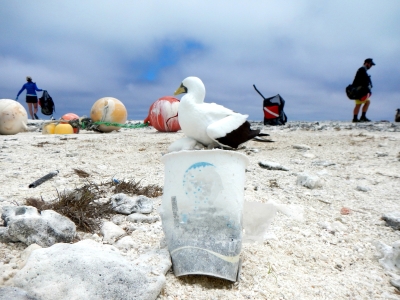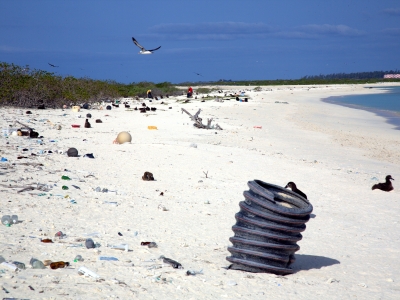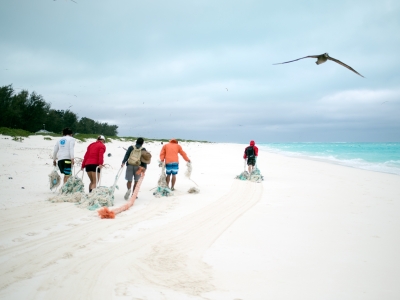The Papahānaumokuākea Marine National Monument (monument) is one of the largest fully protected marine conservation area on the planet and spans 582,578 square miles, an area larger than all the country's National Parks combined. These protected Hawaiian islands are located to the northwest of the archipelago's main eight islands. Papahānaumokuākea is integral to Native Hawaiian culture and is a sacred landscape. The monument, which is also a United Nations Educational, Scientific, and Cultural Organization’s World Heritage Site, is mostly uninhabited by people and located far away from human populations. The monument is home to more than 7,000 marine species and a total of 23 species that are listed under the U.S. Endangered Species Act, including the threatened Hawaiian green sea turtle, endangered Hawaiian monk seal, and the critically endangered Laysan duck.
Marine Debris in the Monument
Despite the distance, massive amounts of marine debris, mostly made up of derelict fishing gear, finds its way onto the shores and reefs of the monument.
An estimated 52 metric tons of derelict fishing gear from commercial fisheries all over the Pacific float into the monument every year, and many of these nets become trapped on the extensive reefs. Derelict fishing nets, ranging in size from a basketball to a small car, continue to catch marine life for years after they are lost and are a constant entanglement threat for the monk seals, green sea turtles, seabirds, and other wildlife that depend on the vast coral reef ecosystem. The reefs themselves are in danger from abrasion and scouring as the heavy nets glide through the currents and snag on vibrant corals, in some cases coming to rest on top of the reef structure. Smaller debris such as plastic bottle caps, lighters, and toothbrushes, can impact seabirds, some of which mistake plastic items for food.
A Legacy of Marine Debris Removal
Removing marine debris is critical for preserving the unique native ecosystem of Papahānaumokuākea. Since 1996, a large-scale effort to remove marine debris from the monument has resulted in 1,167 metric tons (more than 2 million pounds) of primarily derelict fishing gear and plastics removed. That’s equivalent to about ten adult blue whales, which is the largest animal on the planet! To combat the debris and mitigate its hazards, multiple partners collaborate on this removal mission every few years to clean debris from the monument and its shores. The NOAA Marine Debris Program has been involved in this effort since the Program was established in 2006, and is now supporting efforts led by the National Fish and Wildlife Foundation and Papahānaumokuākea Marine Debris Project. Learn more about the history of the removal missions in the monument.
Once a removal mission is completed, the tons of nets and plastics are sorted and disposed of. Some debris is reused and repurposed for education and art, while some goes to the Hawai‘i Nets to Energy Program to create electricity for homes across the island of O‘ahu.

Blog

Current Mission Partners

Additional Resources
- Northwestern Hawaiian Islands Marine Debris Removal Mission Webinar
- StoryMap 2018 Marine Debris Removal and Assessment in the Northwestern Hawaiian…
- Coral Reef Ecosystem Program (CREP) 2016 Northwest Hawaiian Island Removal Stor…
- Coral Reef Ecosystem Program (CREP) Marine Debris Removal
- Papahānaumokuākea Marine National Monument Marine Debris Removal
- 2018 Papahānaumokuākea Marine National Monument Removal Booklet
- 2015 Papahānaumokuākea Marine National Monument Removal Booklet
- 2014 Northwest Hawaiian Island Removal Booklet
- 2013 Northwest Hawaiian Island Removal Booklet
- 2012 Northwest Hawaiian Island Removal Booklet
- 2011 Northwest Hawaiian Island Removal Booklet
- Reddit Ask Me Anything: Removing marine debris from the Papahānaumokuākea Marin…
- Restoring Coral Reefs: Removing Marine Debris from the Papahānaumokuākea Marine…

Past Mission Partners
- Joint Institute for Marine and Atmospheric Research and University of Hawai‘i (…
- NOAA Pacific Islands Fisheries Science Center (PIFSC)
- NOAA Office of National Marine Sanctuaries
- Radius Recycling (Formerly Schnitzer Steel Hawai‘i Corporation)
- H-Power (Covanta Energy)
- National Marine Sanctuaries Foundation (NMSF)
- State of Hawai‘i
 An official website of the United States government.
An official website of the United States government. 































